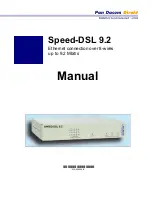
www.cooperbussmann.com/wirelessresources
Cooper Bussmann 945U-E Wireless Ethernet Modem & Device Server User Manual
11
Rev Version 2.14
C
hapTEr
2 - INSTaLLaTION
2.0 General
The 945U-E modules are housed in a rugged aluminum case suitable for DIN-rail mounting. Terminals will accept
wires up to 2.5 mm2 (12 gauge) in size. All connections to the module must be SELV (Safety Extra Low Voltage).
Normal 110-250V mains supply must not be connected to any terminal of the 945U-E module. Refer to “2.2 Power
Supply.”
Before installing a new system, it is preferable to bench test the complete system. Configuration problems are
easier to recognize when the system units are adjacent. Following installation, the most common problem is poor
communications caused by incorrectly installed antennas, radio interference on the same channel, or the radio path
being inadequate. If the radio path is a problem (for example, the path is too long or obstructed), a higher
performance antenna or a higher mounting point for the antenna may rectify the problem. Alternatively, use an
intermediate 945U-E module as a repeater.
The
945U-E Installation Guide provides an installation drawing appropriate to most applications. Further information
is detailed below. Each 945U-E module should be effectively earthed via the “GND” terminal on the back of the
module. This is to ensure that the surge protection circuits inside are effective.
2.1 Antenna Installation
The 945U-E module will operate reliably over large distances. However, the achievable distances will vary with the
application, radio model, type and location of antennas, the degree of radio interference, and obstructions (such as
buildings or trees) to the radio path.
The maximum range achievable depends on the radio model, the regulated RF power permitted in your country,
and whether you use separate transmit and receive antennas. A 945U-E (900 MHz) with a single antenna, 6.2 miles
can be achieved in USA, Canada (4W ERP) and 10 km in Australia, New Zealand (1W ERP).
To achieve the maximum transmission distance, the antennas should be raised above intermediate obstructions
so the radio path is true line-of-sight. The modules will operate reliably with some obstruction of the radio path,
although the reliable distance will be reduced. Obstructions that are close to either antenna will have more of a
blocking affect than obstructions in the middle of the radio path.
The 945U-E modules provide a diagnostic feature that displays the radio signal strength of transmissions. Refer to
“Chapter 4 - DIAGNOSTICS.”
Line-of-sight paths are only necessary to obtain the maximum range. Obstructions will reduce the range, however
may not prevent a reliable path. A larger amount of obstruction can be tolerated for shorter distances. For short
distances, it is possible to mount the antennas inside buildings. An obstructed path requires testing to determine if
the path will be reliable. Refer to “4.7 Testing Radio Paths.”
Where it is not possible to achieve reliable communications between two 945U-E modules, then a third 945U-E
module may be used to receive the message and re-transmit it. This module is referred to as a repeater. This
module may also have a host device connected to it.
The 945U-E unit has two antenna connections at the top of the module, allowing for two antennas to be fitted to
the module if need be. By default the right connector labeled TX/RX is the main connection used to transmitter
and receiver. The left connector, labeled “RX,” is not connected unless configured as described in “3.9 Advanced
Radio Configuration.” Each antenna port can be configured for TX only, RX only or Diversity (TX and RX). Selection
can be made by choosing one of the options from TX Antenna / RX Antenna on the Advanced Radio Configuration
page.
NOTE When only one antenna is used, it must be connected to the TX / RX connector.
Antenna Diversity
There are two main reasons for using Antenna diversity. The first is to improve the reliability of a radio link that may
be affected by multipath signals. Often if radio signals are transmitted in built-up area the signal can get reflected
off different surfaces and when these signals are received they can cancel each other out due to slightly different












































